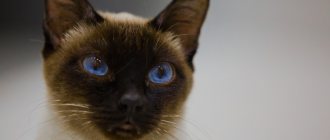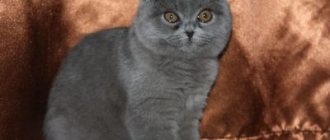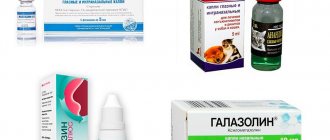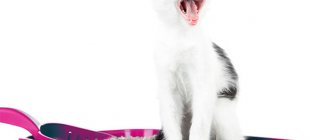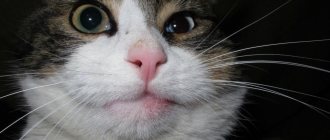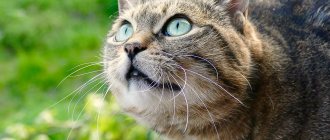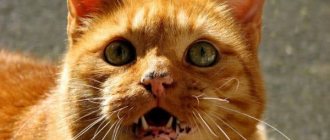Causes
The factors leading to teary eyes are varied. There are situations when it is a physiological norm.
Tears in a cat are a normal reaction of the body if:
- no swelling;
- the pupil reacts normally to light;
- the color of the discharge is transparent, without shades or impurities of pus;
- no signs of foreign objects;
- the shell has not changed color;
- the animal does not experience discomfort.
In addition, some breeds have a predisposition due to anatomical features. For example, the tear duct in the Scottish and British breeds is too short, while in the Persian it is curved. Kittens are genetically predisposed to tearfulness.
In these cases, it is enough to wipe the eyes with a sterile napkin and periodically rinse them with chamomile decoction; no additional procedures are required without changing the transparency of the tears.
Also normal is morning whitish discharge in the corners of the eyes, which is the result of the cleansing work of the lacrimal glands. The cat independently removes accumulated crusts from the eyes, but if this does not happen, the owner can help the pet with a napkin or swab soaked in saline solution or regular clean warm water.
In kittens that are just opening their eyes, increased tear production is a reaction to a physiological change that protects their delicate eyes. If the tears are transparent and not viscous, there is no reason to worry. They last no more than one week.
Why do my Scottish Fold kitten's eyes water?
Tearfulness in Scottish Fold kittens is due to the physiological characteristics of the breed. The skull of the British, Persian and Scottish breeds has a flattened shape. As a result, the tear trough is shorter than in other cats. This is also accompanied by narrow tear ducts. Normally, all representatives of the cat family have transparent tear secretions. But in ordinary cats, the nasolacrimal passages are wide, and secretions come out through them. For the British they flow outwards.
Therefore, the release of a small amount of tear fluid is considered normal. This is especially noticeable after the animal sleeps. Kittens have stronger tearing than adult representatives of the British breed. Healthy tear secretions have a watery consistency.
Pathologies
Any change in the animal's condition requires urgent contact with a veterinarian. The owner should be wary if:
- dullness and change in eye color;
- unnatural reaction of the pupil to light;
- change in the shape of the eyeball;
- the occurrence of edema;
- change in color or viscosity of the secretion,
- the appearance of purulent discharge;
- increased body temperature;
- presence of foreign bodies;
- change in color of the mucous membrane;
- runny nose;
- blood;
- strange behavior of the animal (tongue sticking out, rapid breathing, rubbing eyes).
Read the article about eye diseases in cats.
Prevention of lacrimation and hygiene of kitten eyes
To avoid negative consequences, you need to carefully monitor your pet’s condition and regularly take preventive measures:
- keep household chemicals out of the reach of animals;
- do not allow various aerosols to come into contact with the mucous membrane (for example, automatic air fresheners);
- while cleaning the room, the cat should be locked in another room;
- Regularly wipe your pet's eyes.
If your animal has unusually excessive lacrimation, you should contact your veterinarian.
Symptoms
If a pathological cause is obvious, all manifestations of the disease should be observed to give the doctor as complete a history as possible to ensure the best decision.
Common cat diseases manifest themselves as follows:
| Symptom | Disease and cause |
| Long and profuse tearing. | Viruses and fungi such as plasmosis: calcivirosis, mycoplasmosis, toxoplasmosis, etc. |
| Pus. | Foreign objects. |
| Edema. | Turn of the century. |
| Cloudiness. | Keratitis, cataract. |
| Black spot. | Dying of the cornea. |
| Tears are accompanied by fever, diarrhea, vomiting, and lethargy. | Feline distemper (panleukopenia). |
| Swelling with cloudiness. | Glaucoma. |
| Swelling in the corners of the eye. | Inflammation of the lacrimal glands. |
| Redness of the membranes, photophobia. | Conjunctivitis. |
| Damage to one eye. | Parasites. |
What to do if your cat's eyes are watery
After the symptoms have been recorded and the first auxiliary measures have been taken, it is necessary to take the cat to the doctor.
First of all, you should tell your veterinarian about:
- age;
- behavior change;
- change in food preferences or lack of appetite;
- reactions to light;
- injuries;
- color of discharge;
- body temperature;
- timing of the last vaccination and treatment against parasites;
- change of environment for the cat.
Self-medication is dangerous and always leads to negative consequences for the animal’s health. Under no circumstances should you:
- use potassium permanganate for rinsing;
- giving an animal human medications without a veterinarian's prescription;
- take antibiotics without consulting a doctor;
The best solution before visiting the veterinarian is to rest the animal. The cat should eat a lot, drink water and stay warm.
If you haven’t had anthelmintic treatment for a long time, now is the time to do it.
Your pet should not freeze or go hungry.
What to do and how to help if a Scottish kitten has watery eyes
If you notice signs of lacrimation or inflammation of the mucous membranes of the eyelid in a Scotsman, then you should not engage in independent treatment. It is imperative to take your Scotsman to the veterinarian. Without an accurate diagnosis, it will not be possible to cure a cat. Moreover, it can cause serious harm to the kitten's health.
At the veterinary clinic, the doctor will need to take a test from the conjunctival sac. Only after all the tests have been carried out in the laboratory can a full-fledged treatment be prescribed to the Scot.
However, if for some reason you cannot immediately go with your Scottish cat to the veterinarian, then you need to know what you need to do to help the cat at home before going to the doctor.
© shutterstock
Approximate treatment plan:
- If the form of the disease is conjunctive in nature, then the first step is to organize an eye wash with an antiseptic. A 0.2% solution of furatsilin is well suited for this purpose. It is necessary to rinse 3 times a day. Before each instillation and other procedures, also rinse. Of the more natural preparations for rinsing, you can use a decoction of chamomile, sage, black tea or calendula.
- Drops are the main treatment. You can instill it with a water-based solution of levomycitin, sofradex, kanamycin, lakrikan or tsiprovet. It is necessary to drip 3 to 5 times a day in accordance with the instructions. Regardless of whether one or two eyelids are affected, it is necessary to drip into both. The course of treatment can be up to 2 weeks.
- You can also use antibiotic ointments. For example, “solcoseryl” gel. Use also up to 2 weeks, 3 times a day.
- To treat allergies in a kitten, only one remedy is effective; identify the cause and eliminate it. Of course, you can suppress its symptoms with the help of hormonal drugs, but this is not safe for the health of a Scot.
- If tears flow in a newborn kitten or one that is not yet strong (up to 1 month), then it is necessary to urgently take the pet to the doctor. You cannot treat your baby on your own. The body's immune systems are still too weak, so the Scot could have gotten some kind of infection.
- Also, it wouldn’t hurt to “deworm” the Scotsman with a good drug, because worms are one of the causes of lacrimation.
Treatment
Self-medication is dangerous for your cat's health. The wrong medications can undermine it even further by attacking the microflora of the intestines, liver and kidneys. Potassium permanganate dries out the delicate mucous membranes of the eye, leading to problems including loss of vision.
The veterinarian knows best what will help the pet. To relieve irritation, the drugs Anandin, Tsiprovet, and Iris are usually prescribed. Bars eye drops can be used as a cure for infections and as a preventative hygiene product. Albucid is often used to relieve lacrimation in a kitten, but only after a prescription from a veterinarian.
For a viral infection, the doctor will prescribe chloramphenicol or tetracycline ointment. If the cause is helminths, you need to find out from the doctor how best to carry out the treatment in this case.
A radical surgical solution is rarely prescribed, for example, if a cat has an entropion of the eyelid. However, there is no need to worry ahead of time - most often, the cause is allergies and colds. In this case, the doctor will tell you how best to carry out prevention and prescribe the vitamin supplements or anti-allergy medications needed for your pet.
Be sure to read the article about vitamin deficiency in cats, because these conditions may be related.
How is the treatment carried out?
A veterinarian will help determine the causes of lacrimation and prescribe treatment according to the identified ailment.
If your fold-eared cat has watery eyes, the animal should be taken to a veterinary clinic. The doctor will conduct the required examinations that will identify the factors that contributed to the development of this condition. If the cause of the problem is inflammation of the mucous membrane, you will need to wipe and rinse the British woman’s eyes with an antiseptic medication. A solution of Furacilin is often prescribed.
The procedure is carried out three times a day.
Veterinarians also prescribe eye drops for the Scottish kitten. You can use Sofradex, Kanamycin and Tsipromed. When British and Scottish people have watery eyes due to allergic reactions, the only treatment is to find the allergen and eliminate contact with it. Sometimes they resort to corticosteroids, but these medications have many side effects, so they are prescribed only in advanced situations.
Rules for washing and instilling eye drops
If one of the points of treatment for a cat is eye drops, then it is important to know how to carry it out while causing minimal discomfort to the pet.
For this you need:
- sterile pipette or syringe;
- product (drops, ointment) at room temperature;
- clean wipes or tampons;
- food to encourage and relieve stress in cats.
It is advisable to carry out the burial with an assistant who will help hold the frightened animal. The cat must be well secured. In extreme cases, it is tied with soft cloth.
With a moistened swab, wipe the pet's eye from the outer corner to the inner, removing crusts and drops of secreted liquid. Then the eye is wiped again with a clean napkin.
Now you can start instilling: open the cat’s eyes wide with the thumb and forefinger, after which the product is quickly instilled directly under the eyelid. Excess liquid is blotted with a napkin, then the cat is rewarded for its bravery and released.
Pregnant and small pets require a special approach. Cats expecting the birth of babies are rarely prescribed medications; rinsing is done with chamomile or calendula decoctions, a tea solution, and in extreme cases, tetracycline ointment is applied. Newborn kittens with high tear production are prescribed Bars or Anandin drops.
Preventive actions
To reduce the likelihood of developing a problem, veterinarians from the Zoovet clinic recommend that pet owners systematically cleanse their visual organs. For these purposes, special solutions are used that can be purchased at pharmacy chains. In addition, you can also use decoctions of medicinal herbs. Medicinal chamomile, calendula and sage are suitable. Black tea will also come to the rescue, from which you will need to make a thick brew. To clean the eyes of a Scottish kitten, you need to dip a cotton swab in the liquid and gently wipe the eyelids. The procedure is recommended to be carried out once a day.
